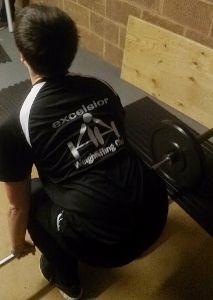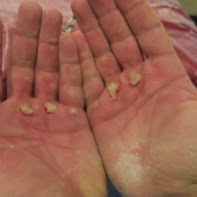How to start weightlifting pt1
“What do I need to start weightlifting?”
 The Excelsior ADC weightlifting club opened in October 2014 in Willand, Cullompton, Devon.
The Excelsior ADC weightlifting club opened in October 2014 in Willand, Cullompton, Devon.
This week I shall be posting a series of blogs that will help people understand weightlifting, and how it applies to their sport.
Essential kit for weightlifting
Weightlifting is a relatively cheap sport for the lifters (more expensive for the gym that has to buy the kit). All you need is some training gear to start with and some flat shoes. Here is what I shall be getting my novice lifters to bring:
- Training shorts/ t-shirts: the longer the shorts the better, as the rough bar may scrape the thighs and cause discomfort. A loose, comfortable t-shirt to wear, but avoid a too baggy one as that may get in the way (see picture above for good kit). Having a tracksuit or warm clothes to wear on the way home is also good. Sweat will dry on you quickly and in the winter you want to avoid shivering before you shower.
 Flat shoes: For beginners, a pair of stout, stable, flat shoes is important. This creates a stable base upon which the lifts can be performed. Running shoes or (Heaven forbid) Vibram 5 fingers are unsuitable for weight lifting. (These handball shoes are a good choice for beginners’ weightlifting shoes.)
Flat shoes: For beginners, a pair of stout, stable, flat shoes is important. This creates a stable base upon which the lifts can be performed. Running shoes or (Heaven forbid) Vibram 5 fingers are unsuitable for weight lifting. (These handball shoes are a good choice for beginners’ weightlifting shoes.)
As you develop your lifting, and you think this could be the sport for you, then investing in some weightlifting shoes is a good idea.
- Water bottle and snack: keeping hydrated throughtout the training session is important. Having a snack for immediately post training that contains some protein and carbohydrate is also essential. The protein helps with muscle repair and rebuilding, the carbohydrate helps provide energy. Chocolate milk, bananas, nuts & raisins or a Tuna sandwich are easy to organsie and affordable.
- Training diary and pen/pencil: you need to record what your are lifting and when. It is important you know what you can lift and this helps measure your progress. Everyone records differently, but as long as the weightlifter know what it means, I am happy as a coach. I have training diaries from 20 years ago, and it is fun to look at old sessions and see how things change.
 Plasters/tape/nail clippers: at some point in your career as a weightlifter you will get blisters on your palms. This will happen sooner rather than later.
Plasters/tape/nail clippers: at some point in your career as a weightlifter you will get blisters on your palms. This will happen sooner rather than later.
For ths short term, putting plasters or tape over them will allow you to continue to train in the session (and refrain from putting blood on my bars!). The nail clippers are a good idea to trim away the edges of the blister to stop them from fraying further. (Before you ask, no weight lifters wear “weight lifting gloves“!)
- Kit bag: you need somewhere to put all this stuff, and I carry a small holdall with these essentials. Packing it the day before training helsp keep you organised. Make sure you label it.
That’s the important kit; quite cheap and accessible really. The weights, bars and platforms are the expensive part of this sport: but the coach and the club bear this burden! Weight lifting belts may be used later in competition, but at the beginning the body needs to develop first.
(Coach Marius Hardiman from Oxford Power Sports demonstrating on our Level 3 Strength and Conditioning Coaching for Sport Course).
Tomorrow: How to start weightlifting pt 2: the lifts
If you live in Mid Devon or Somerset and wish to find out more about weightlifting, then please email me here

James,
Will you be doing any Olympic lifting courses in the Plymouth area or alternatively can you direct me towards the right person who might be keen to take on a few of my U14’s rugby players who may benefit from such a program as part of pre-season S&C?
Kind Regards
Adam
Hi Adam,
I wouldn’t recommned your under 14s team do this. They need a structured programme to help their all round athletic development.
They need to learn how to control their own body before they try to move external weights.
That is what the Sports Training System is designed to do, ofr athletes who can’t make it to train with me.
Alternatively, come to our next workshop on May 27th (under courses) in Exeter, to see how to get started.
Hello,
I am interested in learning the olympic lifts. I have done them but need someone to correct my posture and help me execute the lifts correctly. Is this something you can help with?
HI Zara, yes it is. I will email you.
Please tell me how I can get signed up and started. Am a complete beginner. Apart from going to the gym the odd time I have never done anything like this I hope it’s not a problem?
Complete beginners are welcome to the club. Email me and I will get you started. Thansk for the enquiry.
Hello, I’m interested in improving my technique. Could you please provide more information about the course? Many thanks.
Hi,
I’ll send you an email.
Hello, I have some very limited experience of olympic weightlifting through a handful of crossfit workouts I did when I was younger. I have recently become interested in the sport and was wondering if you offer coaching for the technique of these lifts and guidance on how to train olympic weightlifting safely?
Thanks
Yes, we do. Technique is the focus of all our sessions. Thanks for signing up for your first session.